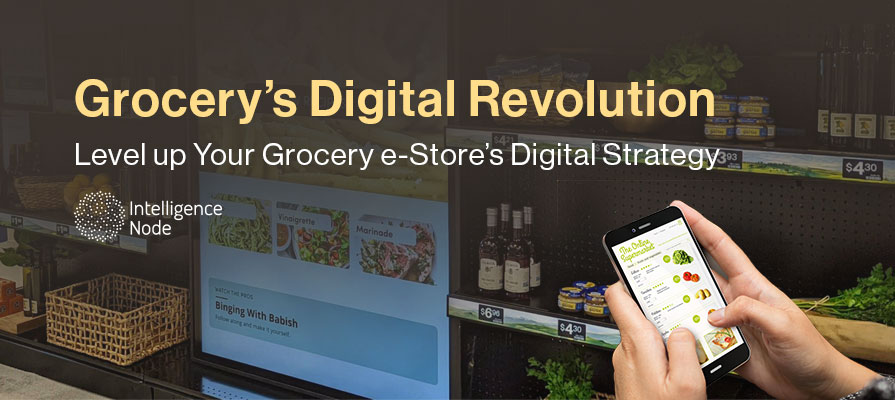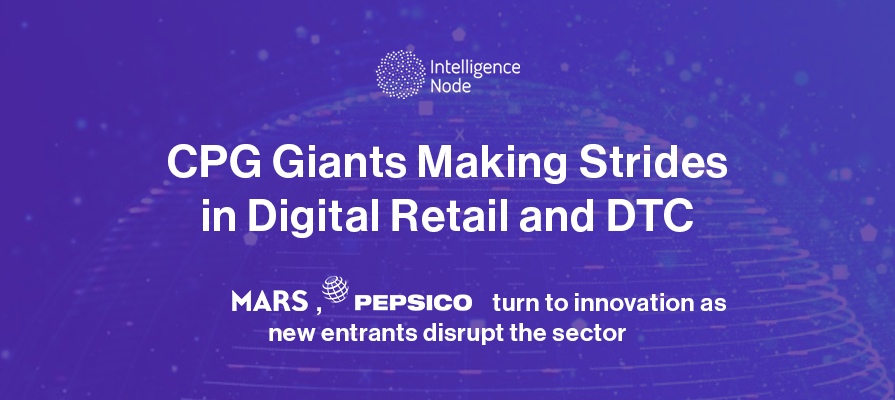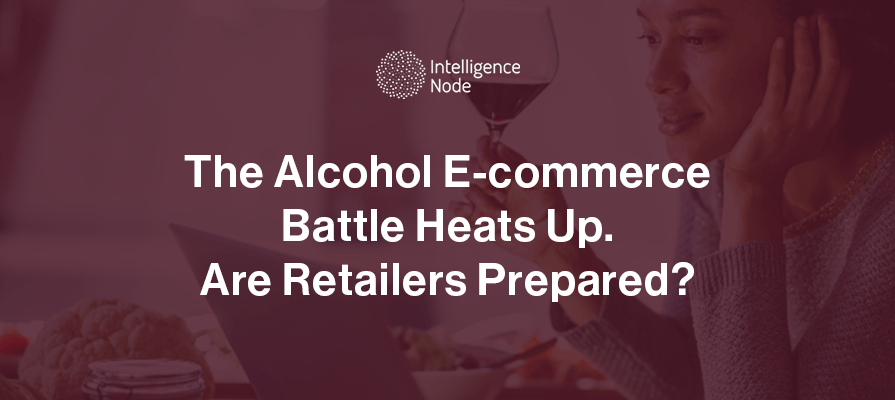How the Top Grocery Leaders are Setting Up for Success
With the onset of digital retail, the world has seen a 360-degree shift in consumer buying behavior and expectations. Subsequently, there have been some immediately tangible effects on the food and grocery market. Forecasts suggest that digital groceries will be a $243 billion market in the US by 2025- with the pandemic then inflation driving more shoppers to e-stores in search of convenience and better prices. Today, most major grocery and CPG/FMCG brands have initiated (and maintained) a strong presence as well as dedicated operations on eCommerce platforms, making their products available across popular marketplaces, DTC websites, and grocery apps. From 11.2% of the overall U.S. e-grocery market in 2022 online grocery sales are expected to increase to a 13.6% share in 2027- displaying a steady digital growth for the segment.
Since 2022, however, online grocery prices have risen faster than any other eCommerce category. This has amplified the need for competitively priced alternatives for digital shoppers- a large number of whom are price conscious millennials. Thus, grocery retailers are on the lookout for effective, reliable, and profitable digital strategies. This has included testing all their existing retail management systems and abilities to keep up with demand and competitor activity. Factors such as quality, price, convenience against loyalty, and private labels against well-loved brands all came to the forefront this year, determining which brands managed to reach success in this quickly evolving industry.
Seven Pillars of Success in the Digital Grocery Industry
For businesses, financial performance indicators such as sales growth, market share, and sales efficiency are often utilized to measure success. However, these factors rely on several measurable “preference drivers,” which reflect recent customer needs and industry trends in an increasingly competitive and dynamic grocery landscape. Retailers who have been able to optimize their performance find themselves comfortably perched atop the rankings- and closer to winning the digital shelf.
Modern day consumer expectations are diverse- basis demographics, income, and more, shoppers today place buying decisions on a myriad of factors. In order of overall impact, here are some top considerations for retailers and consumers alike:
Price & Discounts:
In 2023’s recessionary environment, rising prices and increased income insecurity has further inflated the number of price-conscious shoppers. Pricing is now more important than ever, and with eCommerce, shoppers can identify their ideal products at the best prices within minutes. Further, our research suggests that discounts are deemed most important in the food and grocery sector. Displaying clear, attractive promotions on key products, applying psychological and competitive pricing strategies to store offerings, and even rewarding customer loyalty with cashbacks and exclusive discounts are great incentives to keep shoppers engaged.
Quality:
Value perception correlates directly with quality and inversely with price. The umbrella term “quality” covers many interrelated facets, such as freshness of the produce, taste of prepared food, hygiene of stores, treatment of shoppers, and availability of high-end products. Further, for brands, quality can also allude to holistic brand experiences, post purchase satisfaction, packaging, familiarity, and overall convenience. Private label products often borrow value perception cues from their positioning, packaging, and store to represent quality and attractiveness to shoppers on a budget.
Digital:
Digital is now an essential channel for overall retail success. Retailers with digital platforms that best deliver personalized, flexible, convenient, and efficient experiences win more customers. Accurate recommendations, online chatbots and sales assistance, easy-to-navigate storefronts, multiple shipping and payment options, and a strong omnichannel connect with shoppers can take your store’s digital shopping experience to the next level. That is, provided the platform is convenient, intuitive, and supports products with strong value perceptions. Top retailers aim to recreate an in-store sense of exploration to maximize sales.
Operations:
Retail operations such as inventory management, assortment planning, consistent stocking, efficient store planning, and more all contribute to effective functioning of any retail store. On digital platforms, product content enrichment (with accurate, clear imagery and detailed descriptions), and up to date pricing and availability data are crucial. Ineffective inventory management runs the risk of high demand products running out of stock- which negatively impacts SERP rankings and customer satisfaction, prompting them to click away in search of ‘better’ e-stores.
Convenience & Speed:
Nearby locations, wide product selections, and trendy product assortments mean that customers don’t need to turn elsewhere for any shopping needs. But with digital retail options in every shopper’s pocket, delivery options and convenience take centre stage. Quick checkouts with flexible shipping, pickup, and returns help shoppers make decisions and purchases. Displaying multiple shipping and return options can help retain a wide range of consumers across segments. In fact, according to a recent Intelligence Node survey, Millennials and Gen Z prioritize speedy shipping over extra delivery charges, while delivery charges are the top reason for cart abandonment across other demographics. Diversification of services and store offerings while maintaining efficiency could be the key to long term success for your grocery e-store.
Top Grocery Retailers of 2023
No matter how big or profitable a business may be, no retailer can conceivably lead the pack in every pillar. The key is strategically allocating your brand’s finite resources in profitable ways. In other words, each retailer has to make certain tradeoffs in its commitment to these Pillars. To illustrate this point, here are six top grocery retailers in America, and how they found success:
Walmart
Walmart, one of the world’s largest retailers, has long been known for its everyday low price (EDLP) strategy. This strategy promises shoppers the lowest possible prices all year, with no need to wait for discounts or promotional periods to grab quality goods on a budget. It has helped the retailer increase customer loyalty, reduce costs, drive sales, and even boost its online marketplace. With its own private label brands like Great Value, the company is recognized worldwide as an ideal destination for any and all home goods and groceries on a budget. Walmart’s EDLP strategy relies on direct sourcing, which allows them to bypass traditional middlemen and negotiate lower prices from manufacturers. This can help keep prices low for both sellers and consumers.
Trader Joe’s
This unconventional specialty grocer and major player in the grocery sector is a prime example in value perception. This is primarily for its commitment to low prices and high quality. Famous for its massive range of trendy and affordable private label grocery products, Trader Joe’s has completely abstained from digital marketplaces and has no online presence. This decision has enabled the company to focus its efforts (and dollars) on in-store experience and top-of-the-line affordability. With 561 stores across America, and an attractive store layout, it has become a reliable stop for families on a budget. This, along with its uniquely laid back ambiance and human touch, has cultivated a particularly niche private brand that has built unbreakable connections with customers nationwide. Several loyal shoppers (or ‘grocery influencers’) even run popular social media accounts to document their unique finds at their local store.
Wegmans
With the top quality ranking and a high convenience score, Wegman’s has earned its place among the best grocery chains in America. Interestingly, however- the store isn’t in the first quartile in any other pillar and ranks notoriously low for pricing. This is where the notion of a tradeoff is most evident: Wegman’s doesn’t need unbeatable prices because its products are percievably worth their costs. According to Market Force, this unwavering commitment to high-quality items and in-store experience alone has vaulted Wegman’s to “America’s favorite grocery retailer.”
Costco
This ambitious bulk retailer’s scores are high in each of the top four Pillars – Price, Quality, Digital, and Operations – with a particular commitment to leading the pack in pricing. With massive, stacked isles of discounted goods, Costco is stocked with all grocery and home goods essentials at highly economical prices year-round. As opposed to the attractive, friendly ambience of a Trader Joe’s or Whole Foods, Costco serves to provide top national and regional brands and private label Kirkland Signature products, intended to be bought in large volumes. Finally, the brand does maintain an online presence at costco.com, where non-members must pay a 5% surcharge on all home deliveries, incentivizing its membership program.
Amazon Fresh
This digital giant was once cited as “having a downward pressure on [grocery] pricing” with its cost comparisons and Prime membership perks. Despite not ranking high for Quality or Convenience, CNN Business stated that Amazon’s “tested playbook for undercutting established players’ prices [is all it takes] to grab market share.” To shop, members need only log into their existing Amazon Prime accounts, the Fresh app, or even flagship product Alexa, which is programmed to automatically add items to a users ‘fresh cart’ upon verbal instruction, winning points for convenience all round. With technological tools and innovative data crunching at its disposal, Amazon’s spot on this list feels secure for years to come. Leveraging their existing delivery network and supplier relationships to smooth out the logistics of their grocery operations, the brand seamlessly joins the top grocery chains worldwide as a fierce competitor.
Kroger
As one of the largest grocery chains in the United States, Kroger has a variety of stores selling groceries, jewellery, petrol, organic foods, pharmaceutical products, and home items. Its cost-effective warehouse-style stores are similar to multi-department superstores with a massive variety of national brand apparel and general merchandise.
Further, its intuitive digital storefront even offers short 30-minute deliveries, made highly popular in the thick of the pandemic for its convenience and reliability. Its unique “fuel points” system awards shoppers one point per dollar spent at their local Kroger, incentivizing shoppers to make bigger purchases, and return frequently to maximize the value of the program. It has been an effective initiative in recent years, as shoppers are eager to redeem these points on their fuel refills as budgets tighten in light of the recession.
In line with modern technological advancements, Kroger offers shoppers the option to link digital accounts to their Kroger cards for added convenience, which allows them to link coupons and discount codes directly to their cards for anytime grocery needs. Kroger regularly promotes weekly ads and digital coupons, and even a ‘free friday downloads’ event that rewards shoppers coupons for free items at random. Kroger has been lauded for moving to the forefront of digital progression which includes “strategic investments” such as “customer-centric technology solutions… space-optimized stores… and smart-priced products.”
And a few others…
- Aldi and Lidl – Two German discount retailers with a limited variety of products, but listed at unbeatable prices that even rival Amazon’s influence on the price war.
- WinCo – Despite being a minor player out west, it scores well due to its “combination of Price and emphasizing Quality in the right places with a focus on the retail basics.”
- Whole Foods – Recognized as one of the more premium grocery retailers in America, Whole Foods competes on quality rather than price. The brand hosts a range of organic and natural products across its 514 stores.
Thus, the key doesn’t necessarily lie with which pillars you prioritize, but how your business can prioritize them. Since similar macro approaches can yield wildly varying results based on micro details, retailers are carefully refining their plans to stay ahead of their competition. And in this day and age – this means turning to solutions founded in advanced technology.
Creating High Value Perception to Incentivize Digital Shoppers
In recent years, the digital shelf has proven itself as the ultimate source of all pricing and product data for modern shoppers. Tech-savvy customers on the lookout for good deals and high quality products can navigate several top options of retailers, brands, and product alternatives within mere minutes, creating a cutthroat environment for retailers to distinguish themselves among competitors. However, as prices increase, shoppers are likely to continue utilizing eCommerce platforms to identify reasonable options and stay within budget, driving more shoppers to digital storefronts. Here, retailers can create opportunities for savings in flexible delivery options, retain convenience with user friendly e-stores and payment plans, and identify products that drive sales to accurately create pricing strategies and discounts that protect margins.
Furthermore, smaller retailers like FreshDirect and NetGrocer dominate a massive share of the online grocery delivery market, showcasing how smaller businesses have grown their share in the eCommerce market competitively against larger counterparts. Inclusion of emergent services such as partnerships with companies like Doordash, Instacart, or Postmates and introducing curbside pickups at the start of social restrictions during early days of COVID-19 also played a part in alternative sales growth, despite not being completely digital in nature. Despite varying numbers and levels of success of eCommerce groceries, all trends point to the same insight; that an omnichannel presence and strategy, in simply its accessibility to consumers with different needs, can help boost sales in a huge way.
Tech Strategies for the Win- Data Analytics & Dynamic Pricing
Robot cashiers may make headlines, but AI has a much wider range of applications to optimize a grocer’s results.
Today, companies of all sizes are implementing technology for a host of forward-thinking initiatives: “assortment planning, big data and data processing, customer insights, customer loyalty, eCommerce, in-store analytics, in-store marketing technology, price optimization, promotion optimization, and promotion targeting.”
More significantly, tech-fueled dynamic pricing has become one of the primary drivers pushing players like Amazon to the forefront of this grocery war. Such a fluid price tag approach (with prices changing up to every ten seconds!) can simultaneously benefit revenue while providing customers improved offers in real-time.
As the use of tech in analyzing grocery data becomes more ubiquitous, Planet Retail director Boris Planer’s proclamation that the “ability to connect with the customer and mine data is going to be one of the main capabilities for the future” rings as true as ever.
Tech Solutions Remain Critical amid Price Wars
Absorbing the endless sea of data gathered from the distinct factors of pricing strategy is a task requiring time and effort, as well as a high degree of tech vigilance. Intelligence Node has created solutions to take this burden off your plate and streamline the entire process to improve your overall competitive advantage.
Our price optimization software is an efficiency-minded price optimizer built to put retailers in the best position both for their customers and relative to the competition. It automates retail pricing and inventory management, reads market trends to recommend the most profitable prices, and traces product histories to fortify future strategizing. Further, our AI-driven technology examines price elasticity, inventory levels, competitive pricing, and more to better determine optimal markups and markdowns.
The best grocery retailers haven’t reached the top by accident. Trader Joe’s, Wegmans, Amazon, Costco, and more have developed superior business models that utilize key pillars to boost emotional connection and financial performance. Intelligence Node’s trend tracking, price monitoring, assortment intelligence, and user-friendly data feeds are a seamless addition to your business’s tech stack, and can boost performance and profitability instantly. With those tools firmly in hand, climbing to the top of the customer preference mountain becomes a much more attainable goal for your retail business.




